Lovisa Holdings: Conceptual Framework & Financial Reporting Analysis
VerifiedAdded on 2023/06/09
|15
|2360
|159
Report
AI Summary
This report examines Lovisa Holdings Limited's compliance with the conceptual framework for financial reporting, focusing on its adherence to International Financial Reporting Standards (IFRS) and Australian Accounting Standards Board (AASB) guidelines. It analyzes the company's recognition criteria for assets, liabilities, incomes, expenses, and equity, evaluating whether Lovisa Holdings follows the qualitative characteristics of the conceptual framework in preparing its financial statements. The report finds that Lovisa Holdings generally complies with the conceptual framework, but recommends the inclusion of five years of financial data in table format to enhance comparability and analysis for users and potential investors. The analysis covers revenue recognition, expense recording, asset valuation, liability management, and equity measurement, ensuring a comprehensive understanding of Lovisa Holdings' financial reporting practices.
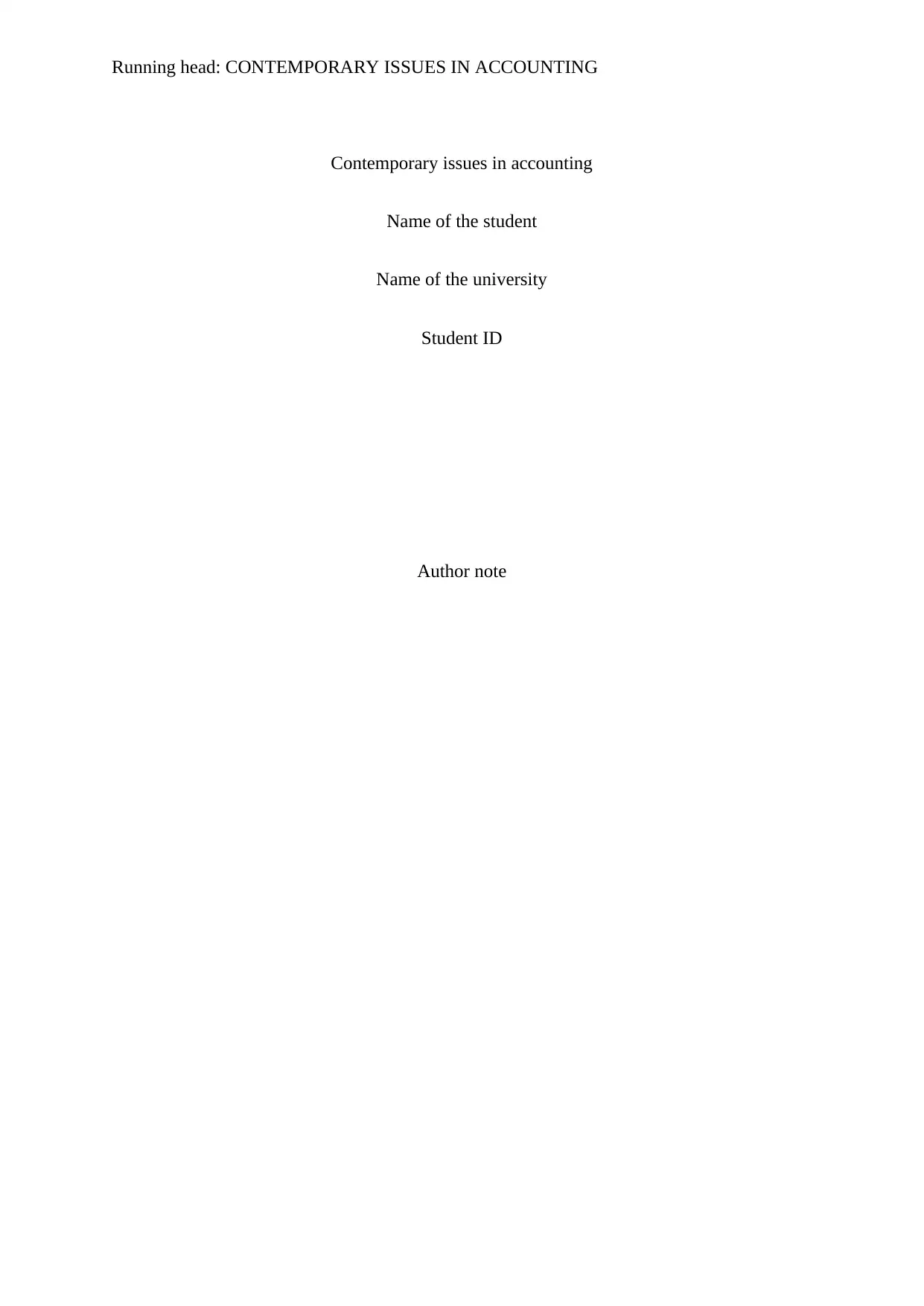
Running head: CONTEMPORARY ISSUES IN ACCOUNTING
Contemporary issues in accounting
Name of the student
Name of the university
Student ID
Author note
Contemporary issues in accounting
Name of the student
Name of the university
Student ID
Author note
Paraphrase This Document
Need a fresh take? Get an instant paraphrase of this document with our AI Paraphraser
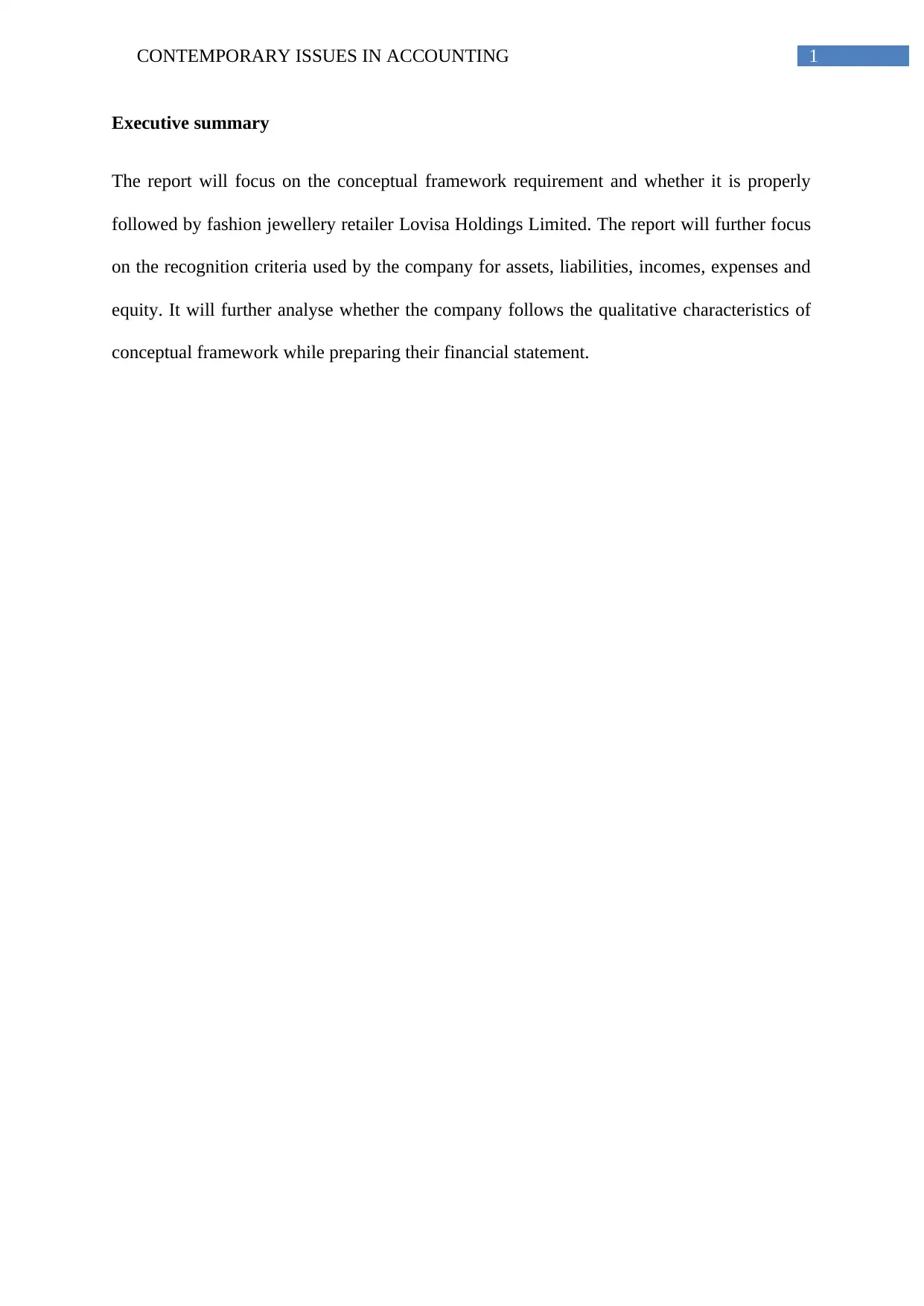
1CONTEMPORARY ISSUES IN ACCOUNTING
Executive summary
The report will focus on the conceptual framework requirement and whether it is properly
followed by fashion jewellery retailer Lovisa Holdings Limited. The report will further focus
on the recognition criteria used by the company for assets, liabilities, incomes, expenses and
equity. It will further analyse whether the company follows the qualitative characteristics of
conceptual framework while preparing their financial statement.
Executive summary
The report will focus on the conceptual framework requirement and whether it is properly
followed by fashion jewellery retailer Lovisa Holdings Limited. The report will further focus
on the recognition criteria used by the company for assets, liabilities, incomes, expenses and
equity. It will further analyse whether the company follows the qualitative characteristics of
conceptual framework while preparing their financial statement.
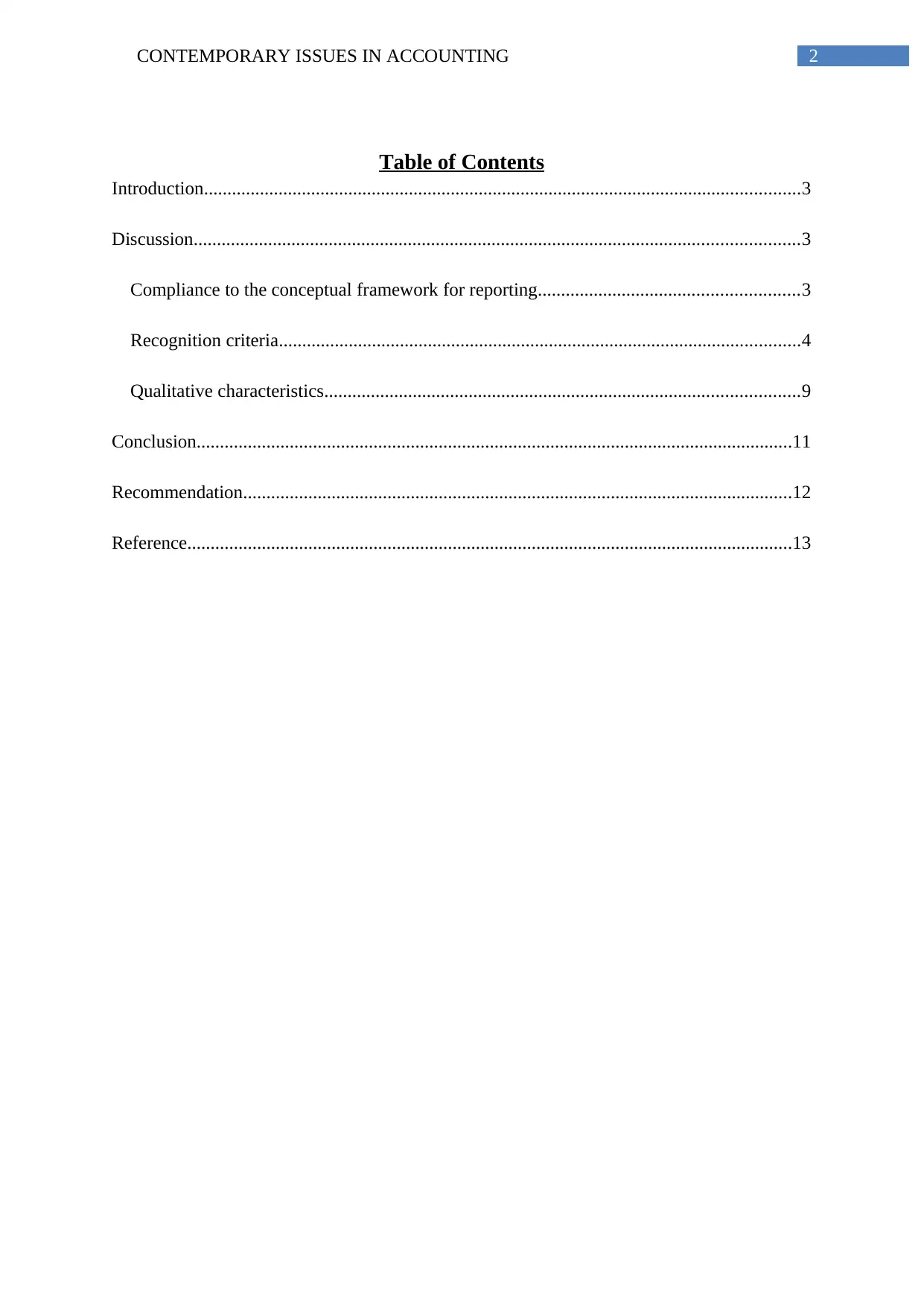
2CONTEMPORARY ISSUES IN ACCOUNTING
Table of Contents
Introduction................................................................................................................................3
Discussion..................................................................................................................................3
Compliance to the conceptual framework for reporting........................................................3
Recognition criteria................................................................................................................4
Qualitative characteristics......................................................................................................9
Conclusion................................................................................................................................11
Recommendation......................................................................................................................12
Reference..................................................................................................................................13
Table of Contents
Introduction................................................................................................................................3
Discussion..................................................................................................................................3
Compliance to the conceptual framework for reporting........................................................3
Recognition criteria................................................................................................................4
Qualitative characteristics......................................................................................................9
Conclusion................................................................................................................................11
Recommendation......................................................................................................................12
Reference..................................................................................................................................13
⊘ This is a preview!⊘
Do you want full access?
Subscribe today to unlock all pages.

Trusted by 1+ million students worldwide
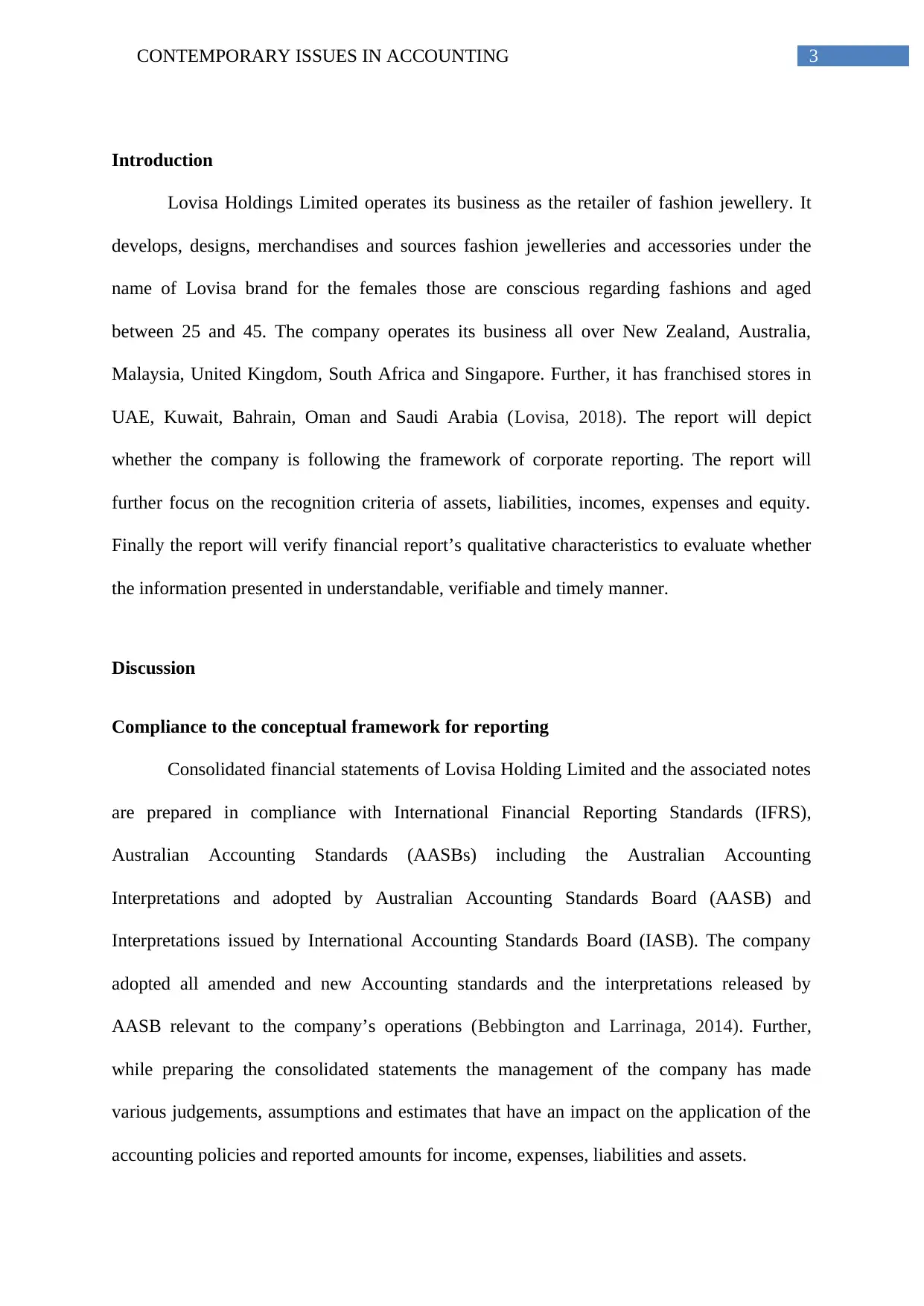
3CONTEMPORARY ISSUES IN ACCOUNTING
Introduction
Lovisa Holdings Limited operates its business as the retailer of fashion jewellery. It
develops, designs, merchandises and sources fashion jewelleries and accessories under the
name of Lovisa brand for the females those are conscious regarding fashions and aged
between 25 and 45. The company operates its business all over New Zealand, Australia,
Malaysia, United Kingdom, South Africa and Singapore. Further, it has franchised stores in
UAE, Kuwait, Bahrain, Oman and Saudi Arabia (Lovisa, 2018). The report will depict
whether the company is following the framework of corporate reporting. The report will
further focus on the recognition criteria of assets, liabilities, incomes, expenses and equity.
Finally the report will verify financial report’s qualitative characteristics to evaluate whether
the information presented in understandable, verifiable and timely manner.
Discussion
Compliance to the conceptual framework for reporting
Consolidated financial statements of Lovisa Holding Limited and the associated notes
are prepared in compliance with International Financial Reporting Standards (IFRS),
Australian Accounting Standards (AASBs) including the Australian Accounting
Interpretations and adopted by Australian Accounting Standards Board (AASB) and
Interpretations issued by International Accounting Standards Board (IASB). The company
adopted all amended and new Accounting standards and the interpretations released by
AASB relevant to the company’s operations (Bebbington and Larrinaga, 2014). Further,
while preparing the consolidated statements the management of the company has made
various judgements, assumptions and estimates that have an impact on the application of the
accounting policies and reported amounts for income, expenses, liabilities and assets.
Introduction
Lovisa Holdings Limited operates its business as the retailer of fashion jewellery. It
develops, designs, merchandises and sources fashion jewelleries and accessories under the
name of Lovisa brand for the females those are conscious regarding fashions and aged
between 25 and 45. The company operates its business all over New Zealand, Australia,
Malaysia, United Kingdom, South Africa and Singapore. Further, it has franchised stores in
UAE, Kuwait, Bahrain, Oman and Saudi Arabia (Lovisa, 2018). The report will depict
whether the company is following the framework of corporate reporting. The report will
further focus on the recognition criteria of assets, liabilities, incomes, expenses and equity.
Finally the report will verify financial report’s qualitative characteristics to evaluate whether
the information presented in understandable, verifiable and timely manner.
Discussion
Compliance to the conceptual framework for reporting
Consolidated financial statements of Lovisa Holding Limited and the associated notes
are prepared in compliance with International Financial Reporting Standards (IFRS),
Australian Accounting Standards (AASBs) including the Australian Accounting
Interpretations and adopted by Australian Accounting Standards Board (AASB) and
Interpretations issued by International Accounting Standards Board (IASB). The company
adopted all amended and new Accounting standards and the interpretations released by
AASB relevant to the company’s operations (Bebbington and Larrinaga, 2014). Further,
while preparing the consolidated statements the management of the company has made
various judgements, assumptions and estimates that have an impact on the application of the
accounting policies and reported amounts for income, expenses, liabilities and assets.
Paraphrase This Document
Need a fresh take? Get an instant paraphrase of this document with our AI Paraphraser
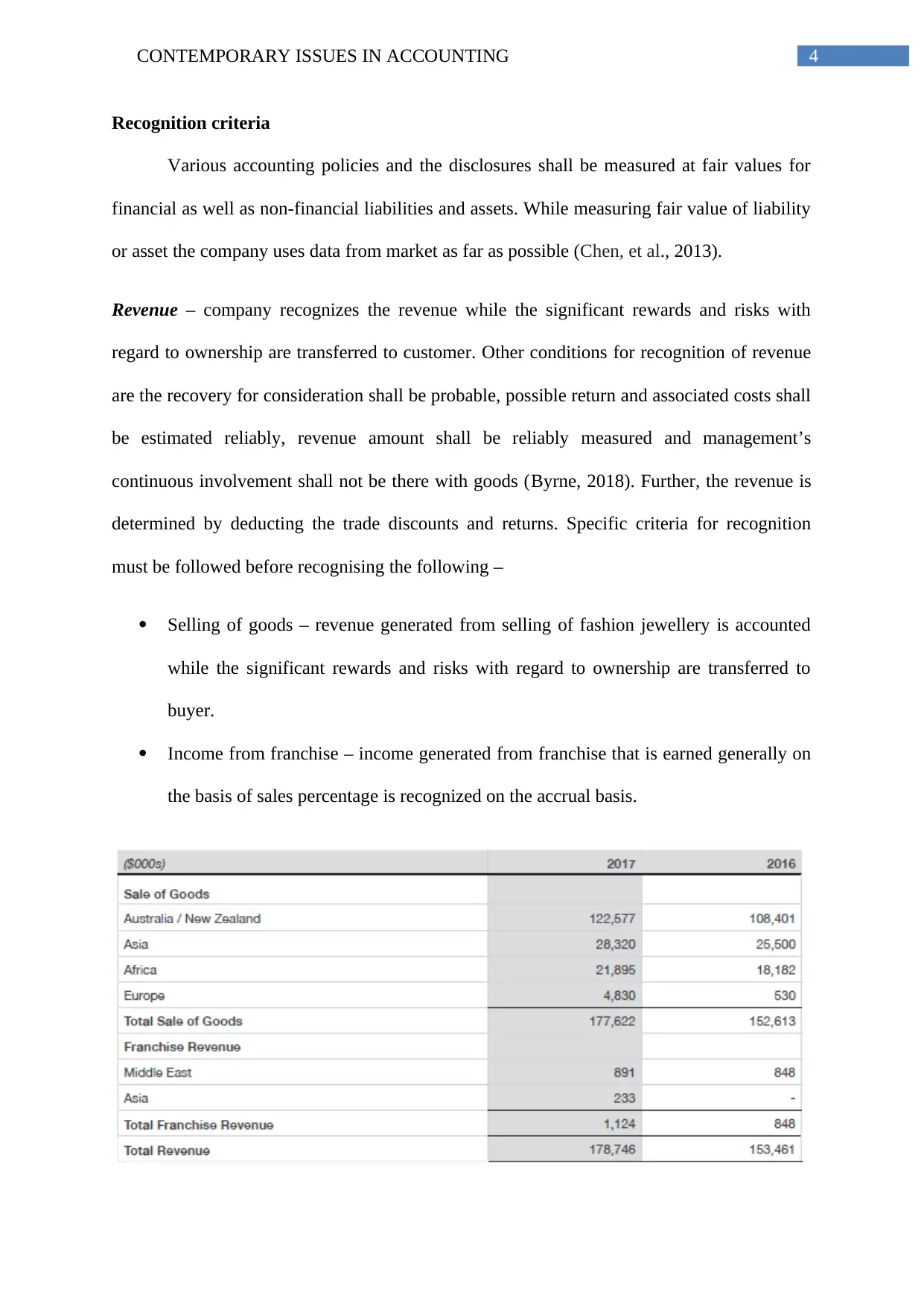
4CONTEMPORARY ISSUES IN ACCOUNTING
Recognition criteria
Various accounting policies and the disclosures shall be measured at fair values for
financial as well as non-financial liabilities and assets. While measuring fair value of liability
or asset the company uses data from market as far as possible (Chen, et al., 2013).
Revenue – company recognizes the revenue while the significant rewards and risks with
regard to ownership are transferred to customer. Other conditions for recognition of revenue
are the recovery for consideration shall be probable, possible return and associated costs shall
be estimated reliably, revenue amount shall be reliably measured and management’s
continuous involvement shall not be there with goods (Byrne, 2018). Further, the revenue is
determined by deducting the trade discounts and returns. Specific criteria for recognition
must be followed before recognising the following –
Selling of goods – revenue generated from selling of fashion jewellery is accounted
while the significant rewards and risks with regard to ownership are transferred to
buyer.
Income from franchise – income generated from franchise that is earned generally on
the basis of sales percentage is recognized on the accrual basis.
Recognition criteria
Various accounting policies and the disclosures shall be measured at fair values for
financial as well as non-financial liabilities and assets. While measuring fair value of liability
or asset the company uses data from market as far as possible (Chen, et al., 2013).
Revenue – company recognizes the revenue while the significant rewards and risks with
regard to ownership are transferred to customer. Other conditions for recognition of revenue
are the recovery for consideration shall be probable, possible return and associated costs shall
be estimated reliably, revenue amount shall be reliably measured and management’s
continuous involvement shall not be there with goods (Byrne, 2018). Further, the revenue is
determined by deducting the trade discounts and returns. Specific criteria for recognition
must be followed before recognising the following –
Selling of goods – revenue generated from selling of fashion jewellery is accounted
while the significant rewards and risks with regard to ownership are transferred to
buyer.
Income from franchise – income generated from franchise that is earned generally on
the basis of sales percentage is recognized on the accrual basis.
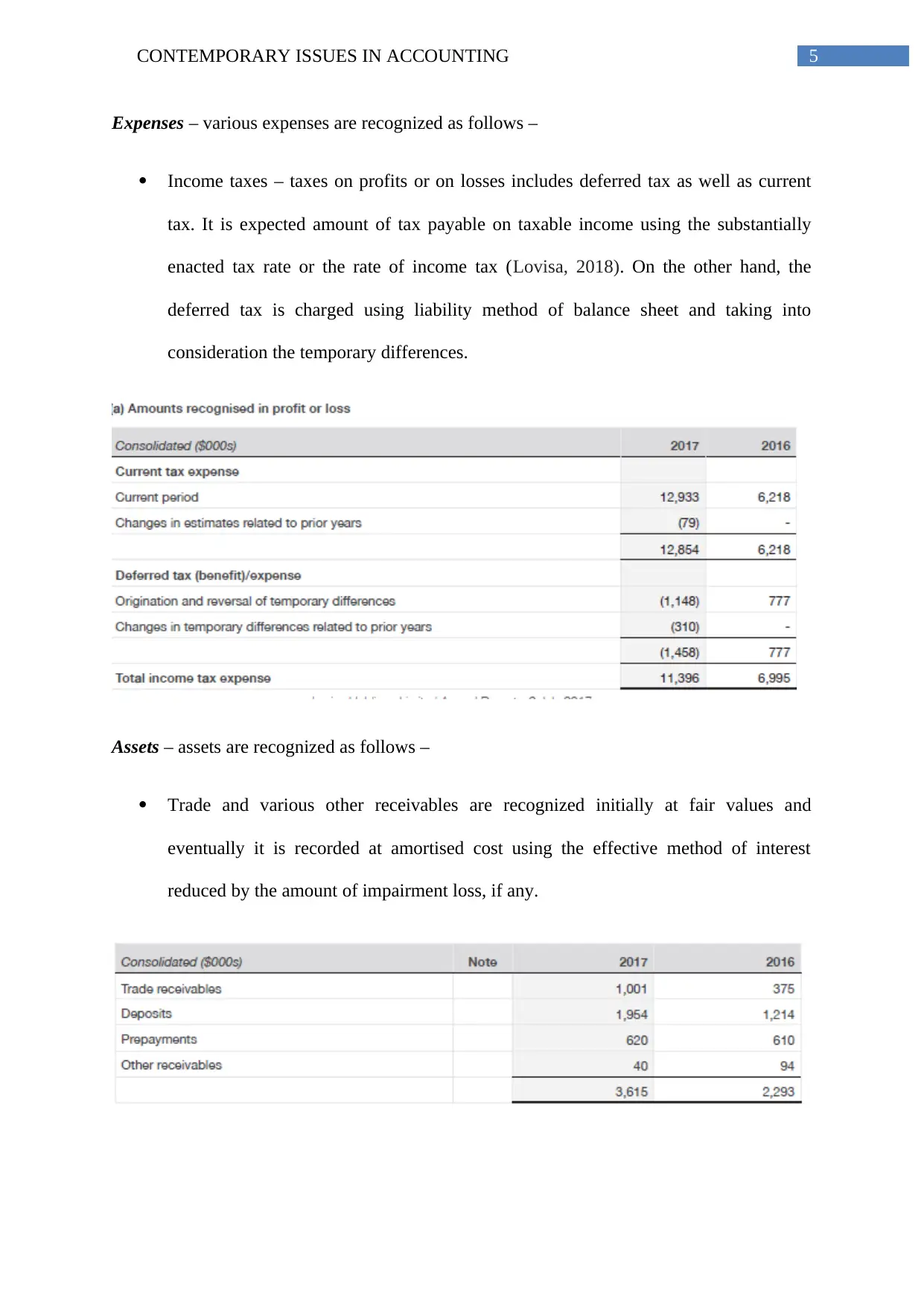
5CONTEMPORARY ISSUES IN ACCOUNTING
Expenses – various expenses are recognized as follows –
Income taxes – taxes on profits or on losses includes deferred tax as well as current
tax. It is expected amount of tax payable on taxable income using the substantially
enacted tax rate or the rate of income tax (Lovisa, 2018). On the other hand, the
deferred tax is charged using liability method of balance sheet and taking into
consideration the temporary differences.
Assets – assets are recognized as follows –
Trade and various other receivables are recognized initially at fair values and
eventually it is recorded at amortised cost using the effective method of interest
reduced by the amount of impairment loss, if any.
Expenses – various expenses are recognized as follows –
Income taxes – taxes on profits or on losses includes deferred tax as well as current
tax. It is expected amount of tax payable on taxable income using the substantially
enacted tax rate or the rate of income tax (Lovisa, 2018). On the other hand, the
deferred tax is charged using liability method of balance sheet and taking into
consideration the temporary differences.
Assets – assets are recognized as follows –
Trade and various other receivables are recognized initially at fair values and
eventually it is recorded at amortised cost using the effective method of interest
reduced by the amount of impairment loss, if any.
⊘ This is a preview!⊘
Do you want full access?
Subscribe today to unlock all pages.

Trusted by 1+ million students worldwide
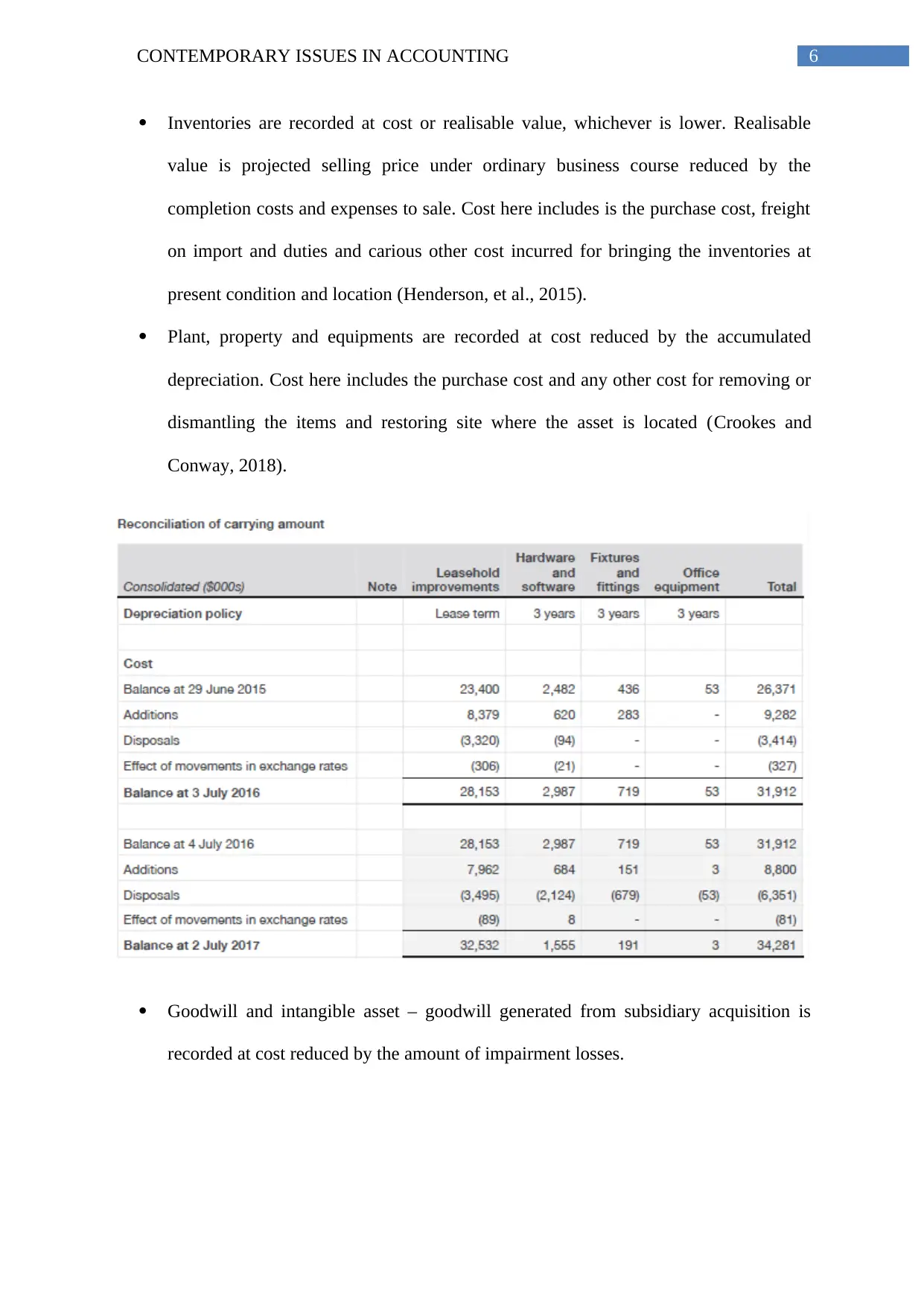
6CONTEMPORARY ISSUES IN ACCOUNTING
Inventories are recorded at cost or realisable value, whichever is lower. Realisable
value is projected selling price under ordinary business course reduced by the
completion costs and expenses to sale. Cost here includes is the purchase cost, freight
on import and duties and carious other cost incurred for bringing the inventories at
present condition and location (Henderson, et al., 2015).
Plant, property and equipments are recorded at cost reduced by the accumulated
depreciation. Cost here includes the purchase cost and any other cost for removing or
dismantling the items and restoring site where the asset is located (Crookes and
Conway, 2018).
Goodwill and intangible asset – goodwill generated from subsidiary acquisition is
recorded at cost reduced by the amount of impairment losses.
Inventories are recorded at cost or realisable value, whichever is lower. Realisable
value is projected selling price under ordinary business course reduced by the
completion costs and expenses to sale. Cost here includes is the purchase cost, freight
on import and duties and carious other cost incurred for bringing the inventories at
present condition and location (Henderson, et al., 2015).
Plant, property and equipments are recorded at cost reduced by the accumulated
depreciation. Cost here includes the purchase cost and any other cost for removing or
dismantling the items and restoring site where the asset is located (Crookes and
Conway, 2018).
Goodwill and intangible asset – goodwill generated from subsidiary acquisition is
recorded at cost reduced by the amount of impairment losses.
Paraphrase This Document
Need a fresh take? Get an instant paraphrase of this document with our AI Paraphraser
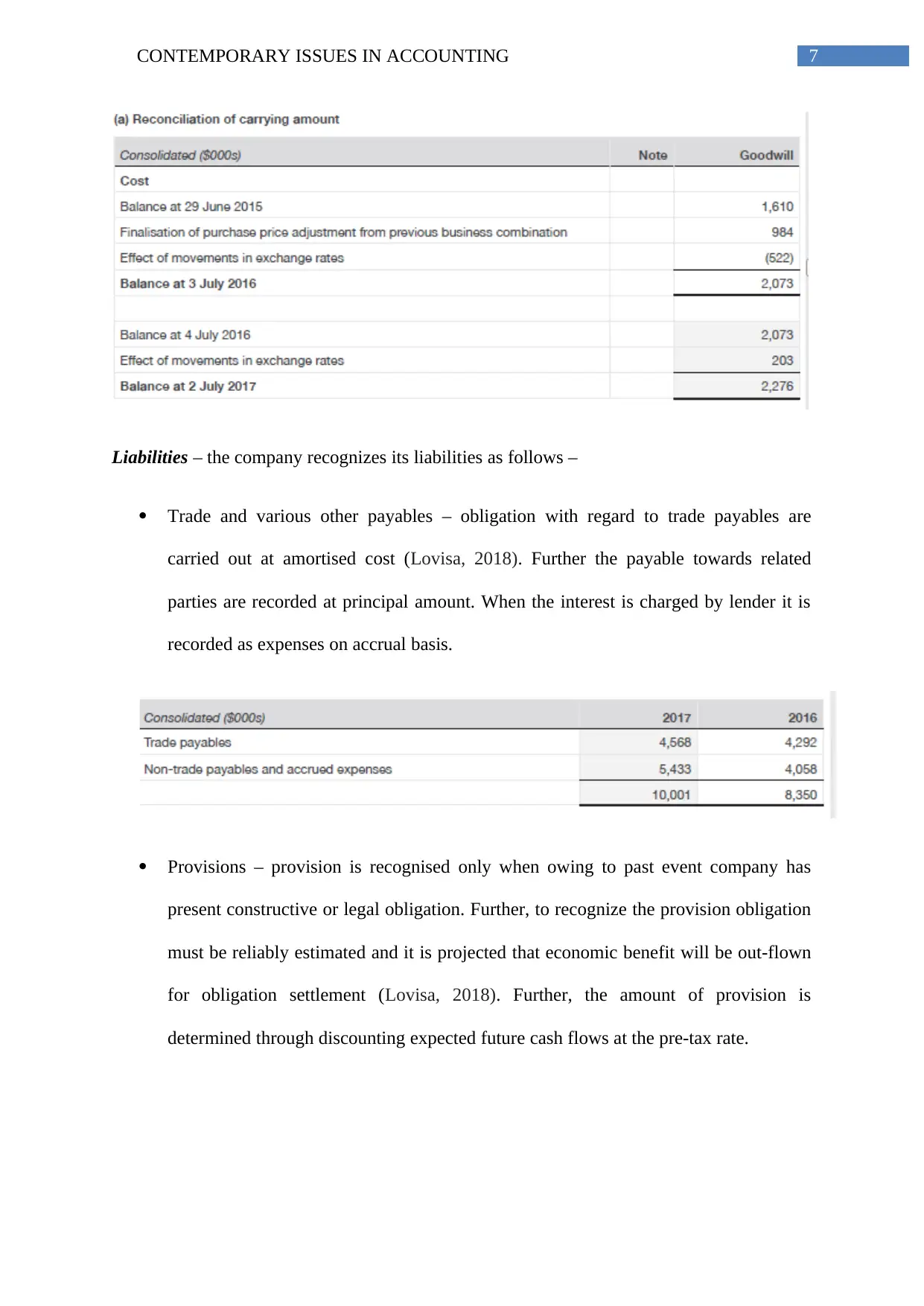
7CONTEMPORARY ISSUES IN ACCOUNTING
Liabilities – the company recognizes its liabilities as follows –
Trade and various other payables – obligation with regard to trade payables are
carried out at amortised cost (Lovisa, 2018). Further the payable towards related
parties are recorded at principal amount. When the interest is charged by lender it is
recorded as expenses on accrual basis.
Provisions – provision is recognised only when owing to past event company has
present constructive or legal obligation. Further, to recognize the provision obligation
must be reliably estimated and it is projected that economic benefit will be out-flown
for obligation settlement (Lovisa, 2018). Further, the amount of provision is
determined through discounting expected future cash flows at the pre-tax rate.
Liabilities – the company recognizes its liabilities as follows –
Trade and various other payables – obligation with regard to trade payables are
carried out at amortised cost (Lovisa, 2018). Further the payable towards related
parties are recorded at principal amount. When the interest is charged by lender it is
recorded as expenses on accrual basis.
Provisions – provision is recognised only when owing to past event company has
present constructive or legal obligation. Further, to recognize the provision obligation
must be reliably estimated and it is projected that economic benefit will be out-flown
for obligation settlement (Lovisa, 2018). Further, the amount of provision is
determined through discounting expected future cash flows at the pre-tax rate.

8CONTEMPORARY ISSUES IN ACCOUNTING
Employee benefits – obligation of the company with regard to long-term benefits for
service is future benefit amount that have earned by the employees in return of their
services in present as well as prior periods. Obligation amount is computed through
increase in projected future salary and wage rates and is discounted by using the
corporate bond rates of Australia (Lovisa, 2018). However, the shorter benefits are
not discounted.
Equity – equities of the company are recognised and measured as follows –
Reserves and capital – ordinary shares are initially recognised at the fair value of
consideration received by the entity. Transaction cost expensed while issuing the
Employee benefits – obligation of the company with regard to long-term benefits for
service is future benefit amount that have earned by the employees in return of their
services in present as well as prior periods. Obligation amount is computed through
increase in projected future salary and wage rates and is discounted by using the
corporate bond rates of Australia (Lovisa, 2018). However, the shorter benefits are
not discounted.
Equity – equities of the company are recognised and measured as follows –
Reserves and capital – ordinary shares are initially recognised at the fair value of
consideration received by the entity. Transaction cost expensed while issuing the
⊘ This is a preview!⊘
Do you want full access?
Subscribe today to unlock all pages.

Trusted by 1+ million students worldwide

9CONTEMPORARY ISSUES IN ACCOUNTING
ordinary shares is directly recognized in equity as deduction from the amount received
as share proceeds.
Borrowings and loans – initially the borrowings and loans are recorded at the fair
values and the amount is reduced by transaction cost attributable directly. Eventually
after initial recognition these are recorded at amortised cost by using the effective
method for interest (Lovisa, 2018).
Qualitative characteristics
The financial information to be useful shall be represented faithfully and relevantly.
Further, the information is considered as useful if it is verifiable, comparable and
understandable and presented in timely manner. Further, fundamental characteristics for the
financial report are faithful representation and relevance (Miller and Power, 2013).
Relevance – if the financial information is relevant it can have an impact on the decision of
the users. Further, the information is capable of creating the difference in decision
irrespective of the fact that some of the users may not take the advantages of it (Li, 2013). It
can be identified from the annual report of Lovisa Holding Limited that the financial
ordinary shares is directly recognized in equity as deduction from the amount received
as share proceeds.
Borrowings and loans – initially the borrowings and loans are recorded at the fair
values and the amount is reduced by transaction cost attributable directly. Eventually
after initial recognition these are recorded at amortised cost by using the effective
method for interest (Lovisa, 2018).
Qualitative characteristics
The financial information to be useful shall be represented faithfully and relevantly.
Further, the information is considered as useful if it is verifiable, comparable and
understandable and presented in timely manner. Further, fundamental characteristics for the
financial report are faithful representation and relevance (Miller and Power, 2013).
Relevance – if the financial information is relevant it can have an impact on the decision of
the users. Further, the information is capable of creating the difference in decision
irrespective of the fact that some of the users may not take the advantages of it (Li, 2013). It
can be identified from the annual report of Lovisa Holding Limited that the financial
Paraphrase This Document
Need a fresh take? Get an instant paraphrase of this document with our AI Paraphraser
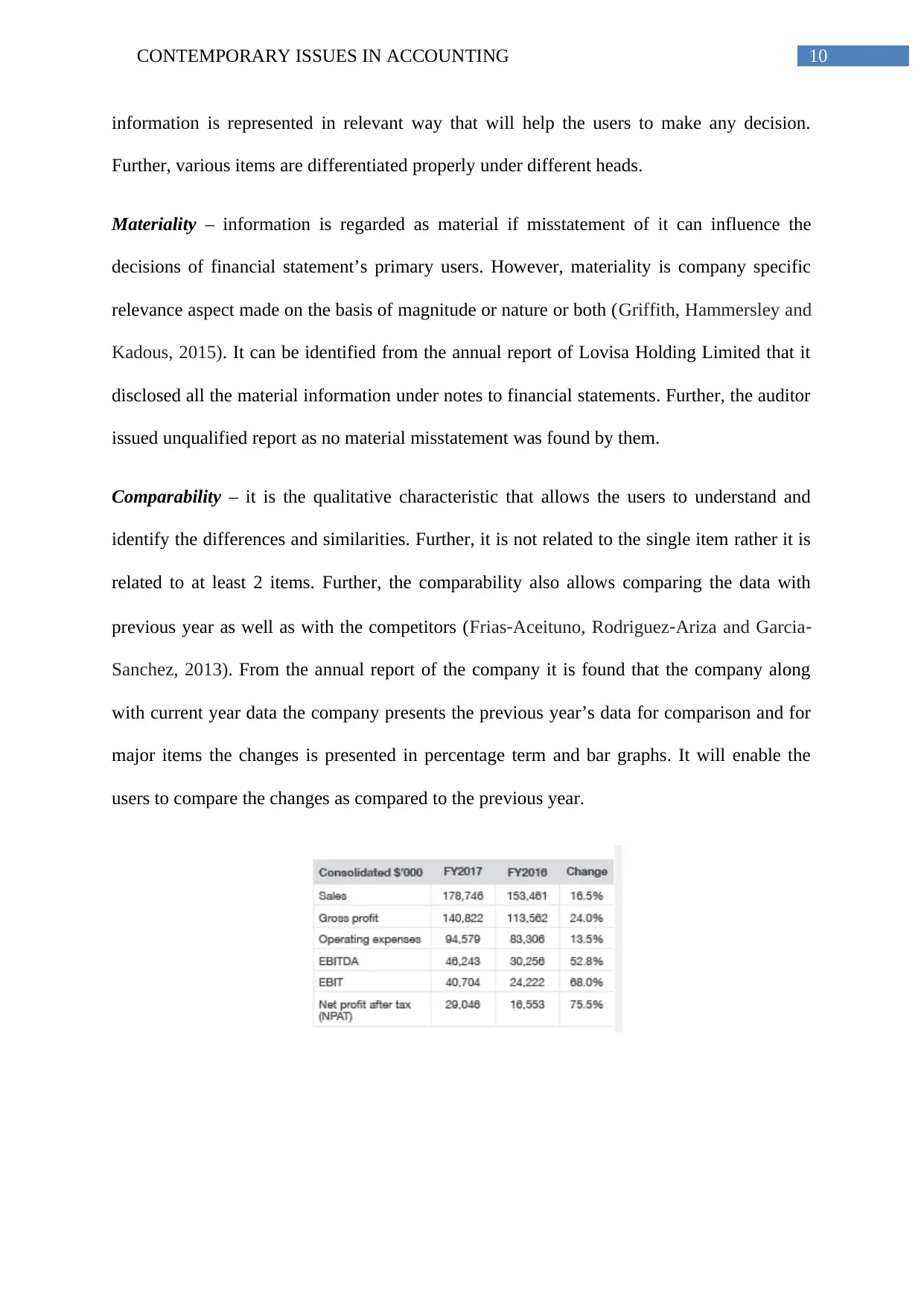
10CONTEMPORARY ISSUES IN ACCOUNTING
information is represented in relevant way that will help the users to make any decision.
Further, various items are differentiated properly under different heads.
Materiality – information is regarded as material if misstatement of it can influence the
decisions of financial statement’s primary users. However, materiality is company specific
relevance aspect made on the basis of magnitude or nature or both (Griffith, Hammersley and
Kadous, 2015). It can be identified from the annual report of Lovisa Holding Limited that it
disclosed all the material information under notes to financial statements. Further, the auditor
issued unqualified report as no material misstatement was found by them.
Comparability – it is the qualitative characteristic that allows the users to understand and
identify the differences and similarities. Further, it is not related to the single item rather it is
related to at least 2 items. Further, the comparability also allows comparing the data with
previous year as well as with the competitors (Frias‐Aceituno, Rodriguez‐Ariza and Garcia‐
Sanchez, 2013). From the annual report of the company it is found that the company along
with current year data the company presents the previous year’s data for comparison and for
major items the changes is presented in percentage term and bar graphs. It will enable the
users to compare the changes as compared to the previous year.
information is represented in relevant way that will help the users to make any decision.
Further, various items are differentiated properly under different heads.
Materiality – information is regarded as material if misstatement of it can influence the
decisions of financial statement’s primary users. However, materiality is company specific
relevance aspect made on the basis of magnitude or nature or both (Griffith, Hammersley and
Kadous, 2015). It can be identified from the annual report of Lovisa Holding Limited that it
disclosed all the material information under notes to financial statements. Further, the auditor
issued unqualified report as no material misstatement was found by them.
Comparability – it is the qualitative characteristic that allows the users to understand and
identify the differences and similarities. Further, it is not related to the single item rather it is
related to at least 2 items. Further, the comparability also allows comparing the data with
previous year as well as with the competitors (Frias‐Aceituno, Rodriguez‐Ariza and Garcia‐
Sanchez, 2013). From the annual report of the company it is found that the company along
with current year data the company presents the previous year’s data for comparison and for
major items the changes is presented in percentage term and bar graphs. It will enable the
users to compare the changes as compared to the previous year.

11CONTEMPORARY ISSUES IN ACCOUNTING
Verifiability – as per the conceptual framework the financial statement shall be associated
with notes for making it verifiable with regard to various items (Francis, Hasan and Wu,
2013). It is found that the annual report of Lovisa Holding Limited is associated with the
supporting notes that clearly explain the accounting treatment of various items and
segregation of various items under accounting heads.
Timeliness – to make the information useful for the users it shall be presented in timely
manner. Further, the information must be related to the period in which it takes place or for
which it is relevant (Cheng, et al., 2013). It is identified that the company publish its annual
financial result at the end of the month of June and half yearly financial result at the end of
the month of December.
Conclusion
It is concluded from above discussion and analysis that Lovisa Holding Limited has
complied with the conceptual framework requirement. All the major items like revenues,
expenses, equity, liabilities and assets are recognized in compliance with the conceptual
framework. Further, the financial statement of the company has been prepared in such way
that qualitative characteristics of the conceptual framework can be followed.
Verifiability – as per the conceptual framework the financial statement shall be associated
with notes for making it verifiable with regard to various items (Francis, Hasan and Wu,
2013). It is found that the annual report of Lovisa Holding Limited is associated with the
supporting notes that clearly explain the accounting treatment of various items and
segregation of various items under accounting heads.
Timeliness – to make the information useful for the users it shall be presented in timely
manner. Further, the information must be related to the period in which it takes place or for
which it is relevant (Cheng, et al., 2013). It is identified that the company publish its annual
financial result at the end of the month of June and half yearly financial result at the end of
the month of December.
Conclusion
It is concluded from above discussion and analysis that Lovisa Holding Limited has
complied with the conceptual framework requirement. All the major items like revenues,
expenses, equity, liabilities and assets are recognized in compliance with the conceptual
framework. Further, the financial statement of the company has been prepared in such way
that qualitative characteristics of the conceptual framework can be followed.
⊘ This is a preview!⊘
Do you want full access?
Subscribe today to unlock all pages.

Trusted by 1+ million students worldwide
1 out of 15
Related Documents
Your All-in-One AI-Powered Toolkit for Academic Success.
+13062052269
info@desklib.com
Available 24*7 on WhatsApp / Email
![[object Object]](/_next/static/media/star-bottom.7253800d.svg)
Unlock your academic potential
Copyright © 2020–2025 A2Z Services. All Rights Reserved. Developed and managed by ZUCOL.


